Travel Dog Crates are essential for pet owners who love to explore the world with their canine companions. At SIXT.VN, we understand the importance of safe and comfortable travel for your dogs, especially when visiting a vibrant country like Vietnam. Let’s dive into the world of travel dog crates and discover how SIXT.VN can make your travel experience with your furry friend seamless and enjoyable, offering pet-friendly accommodations and reliable transportation services.
1. What Are Travel Dog Crates and Why Are They Important?
Travel dog crates are specifically designed enclosures used to transport dogs safely and comfortably. They are important for several reasons:
- Safety: A secure crate prevents your dog from roaming freely in the car, reducing the risk of accidents. According to a study by the American Veterinary Medical Association (AVMA) in 2020, dogs are safer during car travel when properly restrained.
- Comfort: Crates provide a familiar and comfortable space for your dog, reducing anxiety during travel.
- Compliance: Many airlines and transportation services require dogs to be transported in appropriate crates.
- Protection: Crates protect your dog from external factors such as weather conditions and unfamiliar environments.
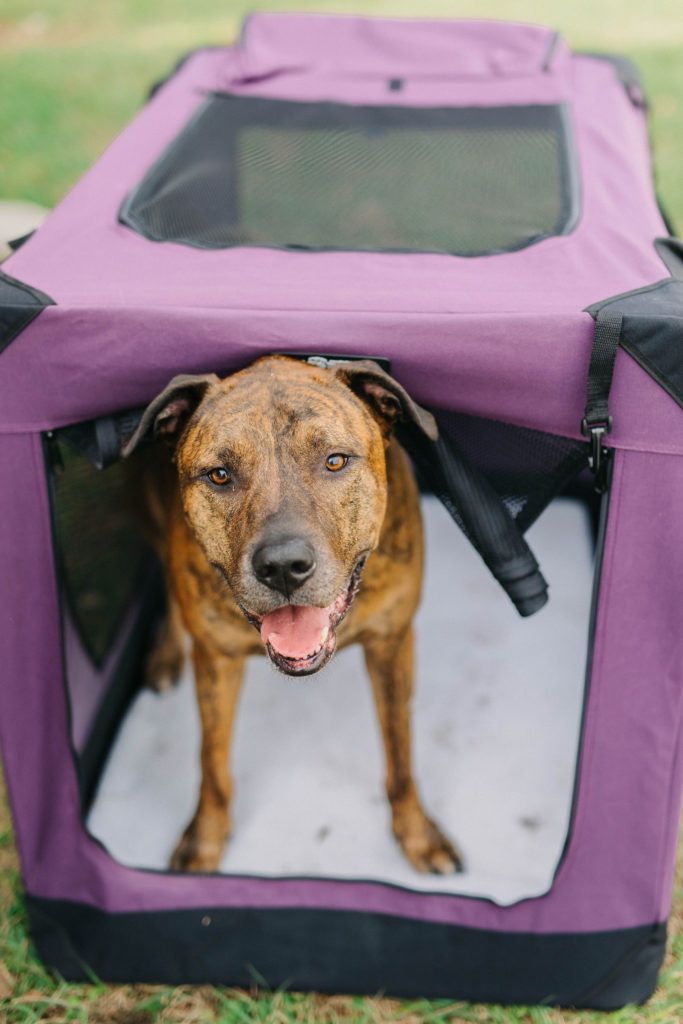 EliteField soft sided crates for large dogs sparkles and sunshine blog
EliteField soft sided crates for large dogs sparkles and sunshine blog
2. What Are the Different Types of Travel Dog Crates?
There are several types of travel dog crates, each with its own advantages and disadvantages:
- Hard-Sided Crates: Made of durable plastic, these crates offer excellent protection and are often required by airlines.
- Soft-Sided Crates: Lightweight and collapsible, these crates are ideal for car travel and short trips.
- Wire Crates: These crates provide good ventilation and visibility, but may not be as secure as hard-sided crates.
- Expandable Crates: These crates can be expanded to provide more space for your dog, making them suitable for longer journeys.
3. How Do I Choose the Right Size Travel Dog Crate?
Choosing the right size crate is crucial for your dog’s comfort and safety. Here’s how to do it:
- Measure Your Dog: Measure your dog’s height (from the top of their head to the ground) and length (from the tip of their nose to the base of their tail).
- Add a Few Inches: Add 2-4 inches to both measurements to ensure your dog has enough room to stand, turn around, and lie down comfortably.
- Consider the Crate Type: Soft-sided crates may require slightly more space to prevent the sides from collapsing on your dog.
For example, if your dog is 20 inches long and 16 inches tall, you’ll need a crate that is at least 22-24 inches long and 18-20 inches tall.
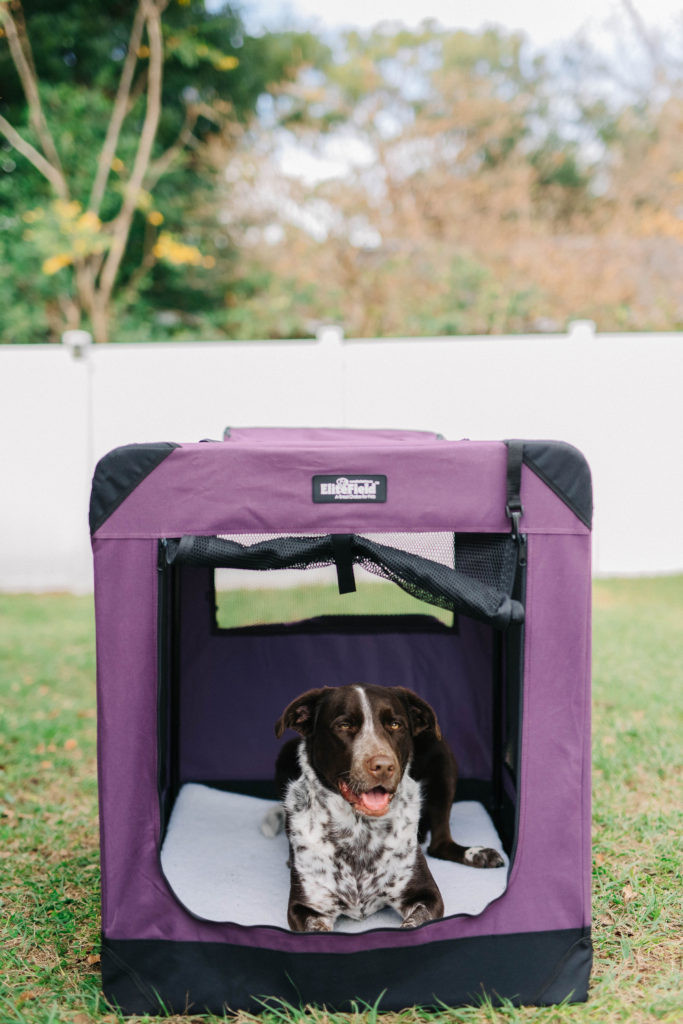 elite field collapsible soft sided dog crate review sparkles and sunshine blog
elite field collapsible soft sided dog crate review sparkles and sunshine blog
4. What Features Should I Look for in a Travel Dog Crate?
When selecting a travel dog crate, consider the following features:
- Ventilation: Adequate ventilation is essential to keep your dog comfortable, especially in warm climates.
- Security: Look for crates with secure latches and durable construction to prevent escapes.
- Portability: Consider the weight and ease of carrying the crate, especially if you’ll be traveling frequently.
- Cleanliness: Choose a crate with a removable, washable bottom tray for easy cleaning.
- Comfort: Add a soft bedding or mat to make the crate more comfortable for your dog.
5. How Can I Acclimate My Dog to Their Travel Crate?
Acclimating your dog to their travel crate can help reduce anxiety and make travel more pleasant. Here’s a step-by-step guide:
- Introduce the Crate: Place the crate in a familiar area of your home and leave the door open.
- Make It Comfortable: Add soft bedding, toys, and treats inside the crate to make it inviting.
- Encourage Exploration: Encourage your dog to enter the crate by tossing treats or toys inside.
- Short Periods Inside: Gradually increase the amount of time your dog spends in the crate, starting with a few minutes and working up to longer periods.
- Positive Reinforcement: Reward your dog with praise and treats when they are calm and relaxed inside the crate.
6. Are Soft-Sided Dog Crates Safe for Air Travel?
Soft-sided dog crates are generally not recommended for air travel, as they may not provide enough protection for your dog. Most airlines require hard-sided crates that meet specific regulations. However, some airlines may allow small dogs to travel in soft-sided carriers under the seat. Always check with the airline before booking your flight.
7. What Are the Best Travel Dog Crates for Car Travel?
For car travel, both hard-sided and soft-sided crates can be suitable, depending on your dog’s size and temperament. Soft-sided crates are lightweight and easy to transport, making them a convenient option for shorter trips. Hard-sided crates offer more protection in case of an accident.
8. How Do I Secure a Dog Crate in My Car?
Securing your dog crate in your car is essential for safety. Here are a few tips:
- Use a Seat Belt: Place the crate on the back seat and secure it with a seat belt.
- Cargo Area: If you have an SUV or hatchback, place the crate in the cargo area and secure it with straps or bungee cords.
- Non-Slip Mat: Place a non-slip mat under the crate to prevent it from sliding around.
- Avoid the Front Seat: Never place a dog crate in the front seat, as the airbag could injure your dog in the event of an accident.
9. What Are the Airline Requirements for Dog Crates?
Airline requirements for dog crates vary, so it’s essential to check with the specific airline before traveling. Here are some general guidelines:
- Hard-Sided: Crates must be hard-sided and made of durable plastic.
- Ventilation: Crates must have adequate ventilation on all four sides.
- Size: The crate must be large enough for your dog to stand, turn around, and lie down comfortably.
- Secure Latches: Crates must have secure latches to prevent escapes.
- Water and Food Bowls: Crates must have accessible water and food bowls.
- Leak-Proof Bottom: The crate must have a leak-proof bottom lined with absorbent material.
10. How Can SIXT.VN Help With My Pet Travel Needs in Vietnam?
SIXT.VN is your trusted partner for pet-friendly travel in Vietnam. We offer a range of services to make your trip with your furry friend as smooth as possible:
- Pet-Friendly Transportation: We provide safe and comfortable transportation options for you and your pet, ensuring a stress-free journey.
- Airport Transfers: Our airport transfer services include pet-friendly vehicles, making it easy to get to and from your accommodation.
- Pet-Friendly Accommodations: We can help you find pet-friendly hotels and accommodations in Hanoi and other destinations in Vietnam.
- Travel Advice: Our team can provide valuable travel advice and tips for traveling with your pet in Vietnam, including information on local regulations and pet-friendly attractions.
With SIXT.VN, you can explore the beauty of Vietnam with your beloved dog, knowing that all your travel needs are taken care of.
11. What Are the Benefits of Using a Travel Dog Crate?
Using a travel dog crate offers numerous benefits for both you and your dog:
- Reduces Anxiety: A familiar crate can help reduce your dog’s anxiety during travel.
- Prevents Accidents: A secure crate prevents your dog from distracting you while driving.
- Provides a Safe Space: The crate serves as a safe and comfortable space for your dog in unfamiliar environments.
- Protects from Injury: In the event of an accident, a crate can protect your dog from serious injury.
- Complies with Regulations: Using a crate ensures you comply with airline and transportation regulations.
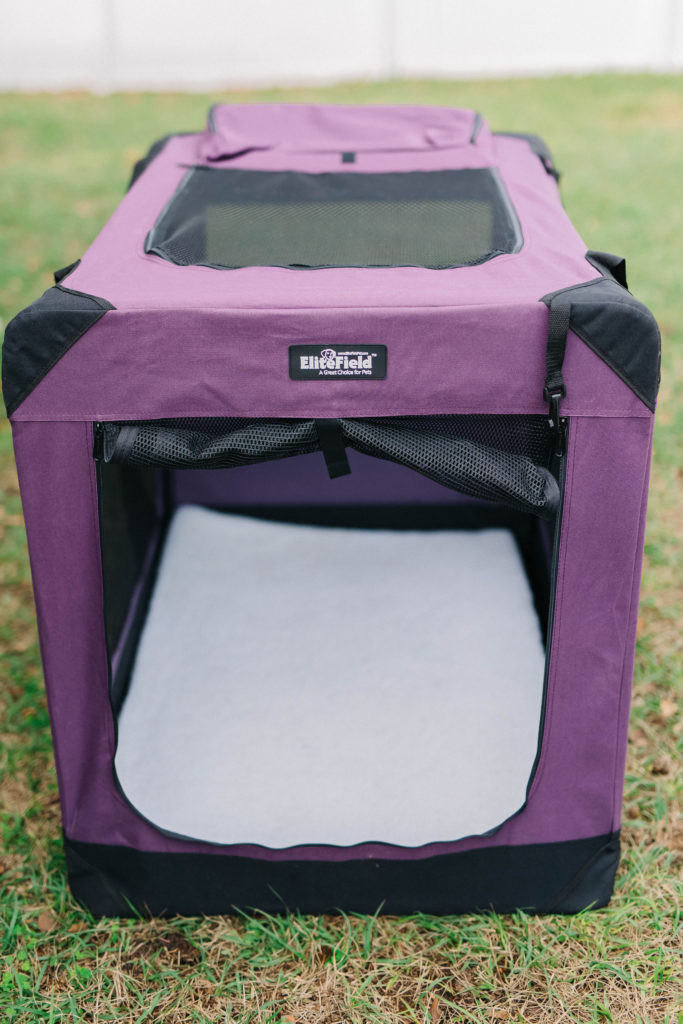 Best soft crate for dogs review sparkles and sunshine blog
Best soft crate for dogs review sparkles and sunshine blog
12. How Do I Choose Between a Hard-Sided and Soft-Sided Dog Crate?
Choosing between a hard-sided and soft-sided dog crate depends on your travel needs and your dog’s temperament. Here’s a comparison to help you decide:
| Feature | Hard-Sided Crate | Soft-Sided Crate |
|---|---|---|
| Durability | More durable, offers better protection | Less durable, suitable for calmer dogs |
| Portability | Heavier, less portable | Lightweight, easy to carry and store |
| Air Travel | Generally required by airlines | Often not allowed for air travel |
| Car Travel | Suitable for all car travel, offers more protection | Best for short trips and well-behaved dogs |
| Cleaning | Easy to clean, often with a removable tray | Can be more difficult to clean, may require hand washing |
| Comfort | Can be less comfortable without added bedding | Often more comfortable with soft fabric |
| Best For | Long trips, air travel, dogs who need more security | Short trips, car travel, calm and well-behaved dogs |
13. What Are Some Common Mistakes to Avoid When Using Travel Dog Crates?
To ensure your dog’s safety and comfort, avoid these common mistakes:
- Using the Wrong Size Crate: A crate that is too small can be uncomfortable, while a crate that is too large may not provide enough security.
- Not Acclimating Your Dog: Introducing the crate gradually can help reduce anxiety and make travel more pleasant.
- Leaving Your Dog Unattended for Too Long: Dogs should not be left in a crate for extended periods, especially in hot or cold weather.
- Not Securing the Crate: An unsecured crate can slide around in the car, increasing the risk of injury.
- Forgetting Essentials: Always pack water, food, and waste bags for your dog.
14. What Are Some Tips for Making Air Travel Easier With My Dog?
Air travel with a dog can be stressful, but these tips can help make the experience smoother:
- Choose the Right Crate: Select a hard-sided crate that meets airline requirements and is the right size for your dog.
- Book a Direct Flight: Direct flights minimize the stress of layovers and reduce the risk of lost luggage (and pets).
- Arrive Early: Give yourself plenty of time to check in and go through security.
- Inform Airline Staff: Let airline staff know that you are traveling with a dog and ask for assistance if needed.
- Stay Calm: Your dog will pick up on your stress, so try to stay calm and relaxed.
15. What Are the Best Travel Dog Crate Brands?
Several brands offer high-quality travel dog crates. Here are some of the best:
- Petmate: Known for their durable and airline-approved hard-sided crates.
- EliteField: Offers a variety of soft-sided crates with excellent features.
- Sherpa: Specializes in comfortable and stylish soft-sided carriers.
- AmazonBasics: Provides affordable and reliable crates for various travel needs.
- Impact Dog Crates: Known for its sturdy and secure crates, ideal for dogs with anxiety.
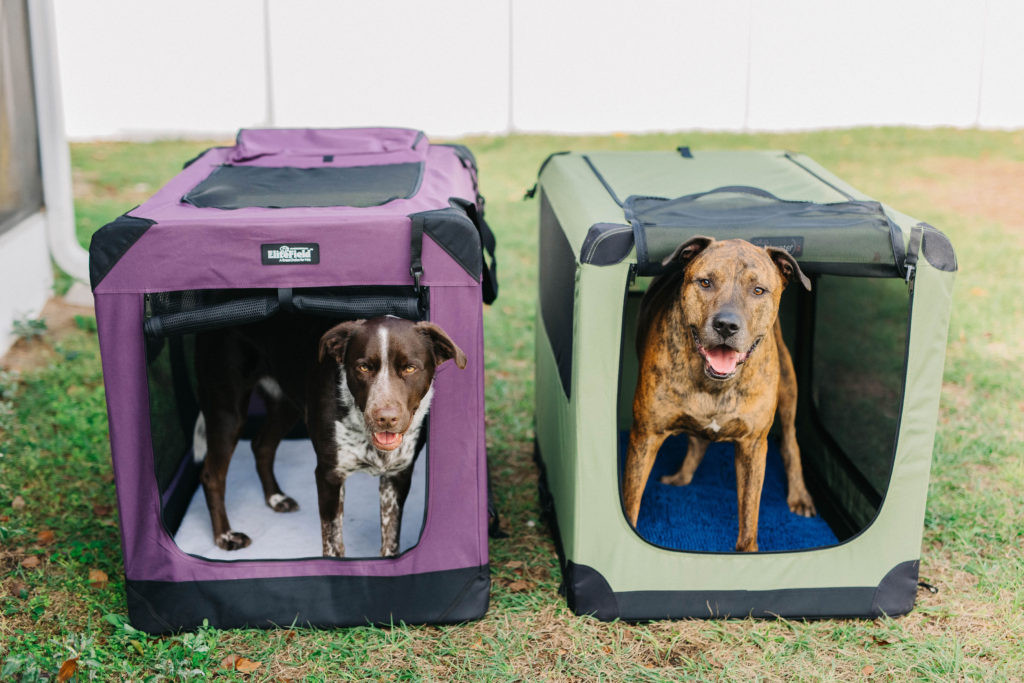 Elitefield soft sided dog crate with noz2noz soft crate sparkles and sunshine blog
Elitefield soft sided dog crate with noz2noz soft crate sparkles and sunshine blog
16. How Do I Clean a Travel Dog Crate?
Regular cleaning is essential to keep your dog’s travel crate hygienic. Here’s how to do it:
- Remove Bedding: Take out any bedding or mats and wash them according to the manufacturer’s instructions.
- Wipe Down Surfaces: Use a damp cloth and mild detergent to wipe down all surfaces of the crate.
- Disinfect: Use a pet-safe disinfectant to kill any bacteria or germs.
- Rinse Thoroughly: Rinse the crate with clean water to remove any soap residue.
- Dry Completely: Allow the crate to air dry completely before using it again.
17. Can I Use a Travel Dog Crate for House Training?
Yes, a travel dog crate can be a valuable tool for house training. Crates can help with house training for a few reasons:
- Natural Instinct: Dogs naturally avoid soiling their sleeping area, so a crate can help them learn to control their bladder and bowels.
- Supervision: Crates provide a safe and confined space where you can supervise your dog and prevent accidents.
- Routine: Using a crate as part of a consistent routine can help your dog learn when and where to eliminate.
18. How Do I Choose the Right Bedding for a Travel Dog Crate?
Choosing the right bedding for your dog’s travel crate can make their journey more comfortable. Here are some factors to consider:
- Comfort: Look for soft and supportive bedding that will cushion your dog’s body.
- Cleanliness: Choose bedding that is easy to clean and can be washed in a washing machine.
- Durability: Select bedding that is durable and can withstand wear and tear.
- Size: Make sure the bedding fits properly in the crate without taking up too much space.
- Material: Consider materials like fleece, memory foam, or orthopedic foam for added comfort.
19. What Are Some Essential Items to Pack for My Dog When Traveling?
When traveling with your dog, be sure to pack these essential items:
- Food and Water: Bring enough food and water for the duration of your trip.
- Bowls: Pack portable food and water bowls.
- Leash and Collar: Always keep your dog on a leash when outside the crate.
- Waste Bags: Clean up after your dog to keep public areas clean.
- Toys: Bring familiar toys to keep your dog entertained.
- Medications: Pack any necessary medications, along with a copy of your dog’s prescription.
- First-Aid Kit: Include a basic first-aid kit for any minor injuries.
- Pet Travel Documents: Keep your pet’s health and vaccination records easily accessible.
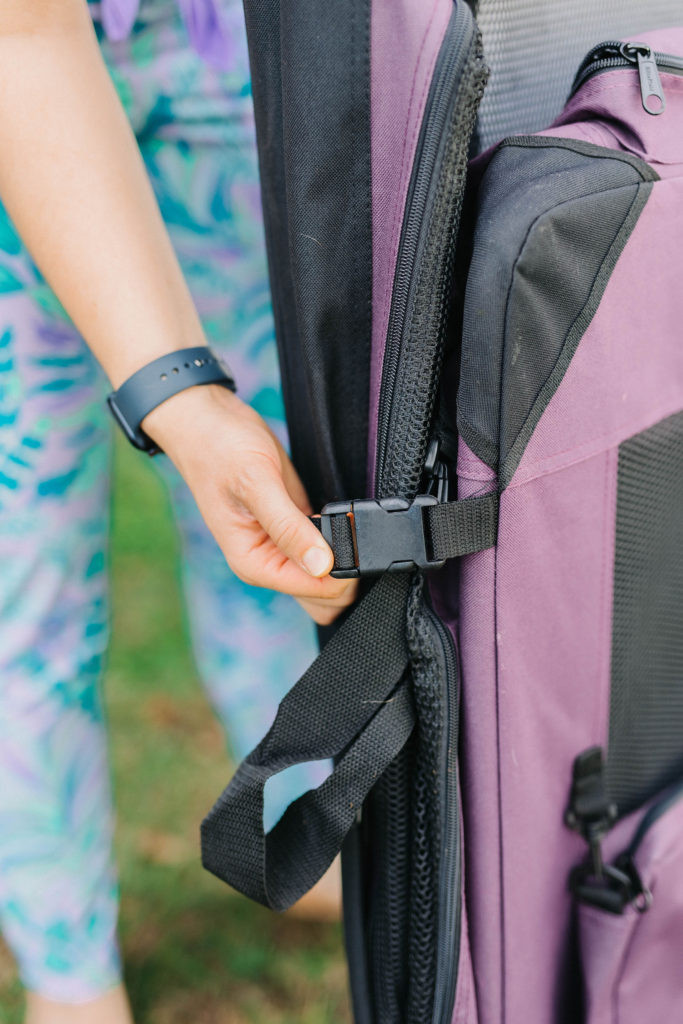 Collapsible dog crates soft review sparkles and sunshine blog
Collapsible dog crates soft review sparkles and sunshine blog
20. How Can I Ensure My Dog’s Safety During a Long Car Trip?
Ensuring your dog’s safety during a long car trip requires careful planning and preparation. Here are some tips:
- Secure the Crate: Always secure the crate with seat belts or straps to prevent it from sliding around.
- Take Frequent Breaks: Stop every few hours to allow your dog to stretch their legs, eliminate, and drink water.
- Never Leave Your Dog Alone in a Parked Car: Temperatures inside a parked car can rise rapidly, even on mild days, posing a serious risk to your dog.
- Provide Plenty of Water: Keep a water bowl accessible to your dog at all times.
- Monitor Your Dog’s Condition: Watch for signs of heatstroke, dehydration, or anxiety, and take appropriate action.
- Keep Air Conditioner running: Keep the air conditioner running so the dog does not feel too hot in the car.
21. What Are Some Common Signs of Stress in Dogs During Travel?
Recognizing signs of stress in your dog during travel can help you take steps to alleviate their anxiety. Common signs include:
- Panting: Excessive panting, especially when it’s not hot.
- Pacing: Restlessness and an inability to settle down.
- Whining: Vocalization indicating distress.
- Trembling: Shaking or trembling.
- Drooling: Excessive drooling.
- Yawning: Frequent yawning, even when not tired.
- Lip Licking: Repeatedly licking their lips.
- Avoidance: Trying to escape or hide.
22. What Are Some Natural Remedies for Dog Travel Anxiety?
If your dog experiences anxiety during travel, consider these natural remedies:
- Calming Treats: These treats often contain ingredients like chamomile, valerian root, and L-tryptophan.
- Pheromone Sprays: Dog-appeasing pheromone (DAP) sprays can help create a sense of calm and security.
- Herbal Supplements: Consult with your veterinarian about using herbal supplements like lavender or ginger.
- Acupressure: Applying gentle pressure to specific acupressure points can help reduce anxiety.
- Comfort Items: Bring familiar blankets or toys to provide a sense of comfort.
23. What Legal Regulations Should I Be Aware of When Traveling With My Dog to Vietnam?
When traveling with your dog to Vietnam, be aware of the following legal regulations:
- Health Certificate: Your dog must have a valid health certificate issued by a licensed veterinarian.
- Vaccination Records: You must provide proof of rabies vaccination.
- Import Permit: Depending on the region you are traveling from, you may need an import permit. Contact the Vietnam Department of Animal Health for specifics.
- Quarantine: Depending on where you are traveling from, your dog may be subject to a quarantine period.
- Microchip: While not always required, having your dog microchipped is recommended.
It’s essential to check the most current regulations with the Vietnamese embassy or consulate in your country before traveling.
24. How Do Travel Dog Crates Help with Dog Dock Diving?
Travel dog crates are incredibly useful for dog dock diving events for several reasons:
- Safe Resting Space: A crate provides a secure and comfortable place for your dog to rest and relax between dives.
- Containment: Keeps your dog safely contained and prevents them from wandering off or getting into trouble.
- Stress Reduction: A familiar crate can help reduce stress and anxiety in a busy and stimulating environment.
- Protection from Elements: Provides shade and shelter from sun or rain.
- Organization: Helps keep your gear organized by providing a designated spot for your dog’s belongings.
25. What is SIXT.VN’s Pet Travel Policy?
SIXT.VN is dedicated to providing pet-friendly travel services, and our pet travel policy reflects this commitment. Here are some highlights:
- Pet-Friendly Vehicles: We offer a selection of pet-friendly vehicles to accommodate you and your furry friend comfortably.
- Transportation Guidelines: Pets must be transported in a secure crate or carrier to ensure their safety and prevent damage to the vehicle.
- Additional Fees: A nominal additional fee may apply to cover the cost of cleaning and sanitizing the vehicle after pet transport.
- Service Animal Policy: Service animals are welcome in all our vehicles at no additional charge, in accordance with applicable laws.
- Advance Notice: We appreciate advance notice when you plan to travel with a pet so that we can ensure the appropriate vehicle is available.
For full details, please contact SIXT.VN directly.
26. What are Some Fun Dog-Friendly Activities to do in Hanoi?
Hanoi is becoming more pet-friendly, and there are several activities you can enjoy with your dog:
- прогулки по паркам: Hanoi has many beautiful parks where you can take your dog for a walk, such as Thong Nhat Park and Lenin Park.
- Cafes: Some cafes in Tay Ho district welcome dogs on their outdoor terraces.
- Hoan Kiem Lake: While dogs aren’t allowed right next to the lake, you can walk around the perimeter on the wider streets.
- Pet Shops: Visiting local pet shops can be a fun way to interact with other pet owners and find unique toys or treats.
Always make sure to keep your dog on a leash and clean up after them to respect local regulations and customs.
27. What are the Most Dog-Friendly Accommodations in Vietnam?
Finding dog-friendly accommodations in Vietnam can require some research, but these places tend to be welcoming:
- Resorts and Hotels in Coastal Areas: Some resorts in Phu Quoc, Nha Trang, and Da Nang are pet-friendly. Always confirm their pet policies when booking.
- Homestays and Guesthouses: Smaller establishments may be more open to accommodating pets. Be sure to inquire in advance.
- Airbnb: Many Airbnb hosts are happy to welcome pets. Use the pet-friendly filter when searching.
Check reviews and pet policies to ensure a comfortable stay for both you and your dog.
28. How Can I Handle My Dog’s Potty Breaks During Long Travel Days?
Managing your dog’s potty breaks during long travel days requires planning:
- Frequent Stops: Schedule regular stops every 2-3 hours for potty breaks.
- Designated Potty Area: Use a consistent potty area with a familiar scent.
- Potty Pads: Use potty pads or absorbent material in the crate to handle accidents.
- Hydration: Offer water at each break to encourage urination.
- Positive Reinforcement: Reward your dog for eliminating in the designated area.
Consistency and patience are key to managing potty breaks effectively.
29. How to Find Emergency Veterinary Care in Vietnam While Traveling?
Finding emergency veterinary care is essential when traveling with your dog:
- Research in Advance: Before your trip, research veterinary clinics in the areas you will be visiting.
- Contact Your Vet: Ask your vet for recommendations and contacts in Vietnam.
- Online Resources: Use online directories and forums to find vet clinics.
- Local Advice: Ask your hotel or local contacts for recommendations.
Keep a list of emergency vet contacts readily available during your trip.
30. What Types of Training Can I Do With My Dog To Prepare Them For Travel?
Preparing your dog for travel involves specific training to make them more comfortable and confident:
- Crate Training: Gradually acclimate your dog to spending time in their crate.
- Car Training: Take short car rides to get them used to the motion.
- Socialization: Expose your dog to different people, places, and sounds.
- Basic Obedience: Reinforce commands like “sit,” “stay,” and “come.”
- Desensitization: Gradually expose them to travel-related stimuli like suitcases, airports, and car noises.
Consistent training can help reduce anxiety and make travel a more positive experience for your dog.
31. Is Pet Insurance Worth Getting When Traveling with My Dog?
Pet insurance can provide peace of mind and financial protection when traveling with your dog:
- Coverage: Pet insurance can cover unexpected veterinary expenses due to illness or injury.
- Emergency Care: Provides coverage for emergency care and hospitalization.
- Trip Cancellation: Some policies offer coverage for trip cancellation due to pet illness.
- Peace of Mind: Knowing you have insurance can reduce stress and allow you to focus on enjoying your trip.
Evaluate your pet’s health history and your travel plans to determine if pet insurance is right for you.
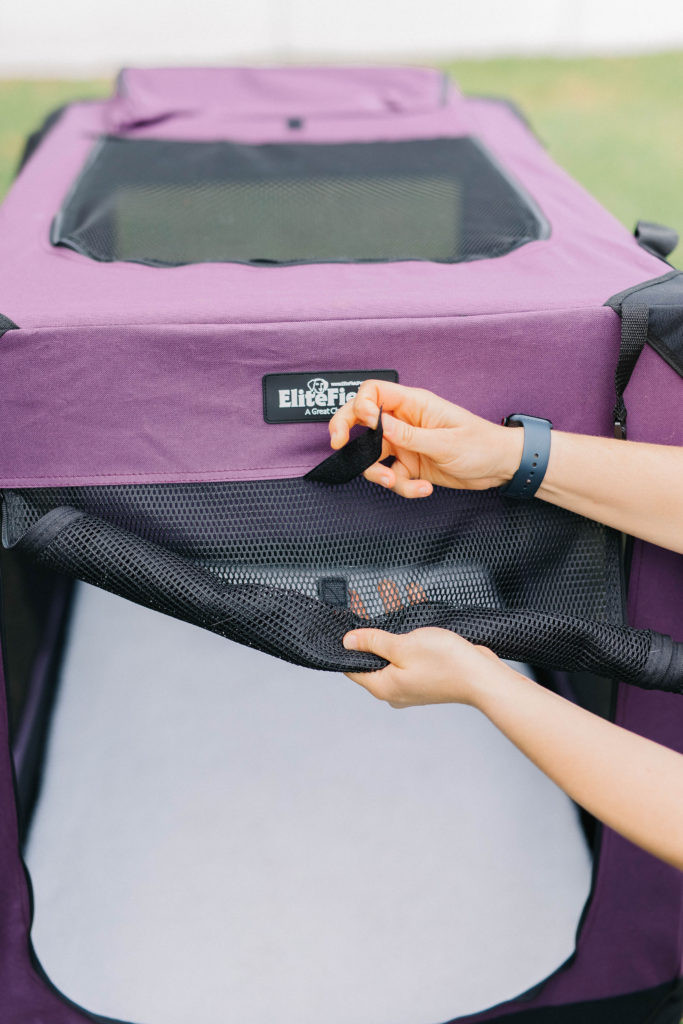 best portable soft dog crate Sparkles and sunshine blog
best portable soft dog crate Sparkles and sunshine blog
32. What Are Some Cultural Differences to Consider When Traveling with a Dog in Vietnam?
When traveling with a dog in Vietnam, be mindful of cultural differences:
- Pet Ownership: Pet ownership is becoming more common, but it is not as widespread as in Western countries.
- Public Perception: Some people may be unfamiliar or uncomfortable with dogs, especially larger breeds.
- Hygiene: Maintaining cleanliness is highly valued, so always clean up after your dog.
- Noise: Be mindful of noise levels and keep your dog from barking excessively.
- Respect: Always be respectful of local customs and traditions.
Being aware of these cultural nuances can help ensure a positive experience for both you and your dog.
33. Can My Dog Sit with Me on Buses or Trains in Vietnam?
Generally, dogs are not allowed to sit with you on buses or trains in Vietnam. Policies vary, so it’s always best to check directly with the transportation provider. Often, small dogs in carriers may be allowed, but larger dogs will likely need to travel as cargo.
34. How Do I Ensure My Dog Stays Cool and Hydrated in Vietnam’s Hot Climate?
Keeping your dog cool and hydrated in Vietnam’s hot climate is essential:
- Frequent Water Breaks: Offer water frequently throughout the day.
- Shade: Provide shade whenever possible.
- Cooling Vest: Consider using a cooling vest or mat.
- Avoid Midday Heat: Avoid strenuous activity during the hottest part of the day.
- Electrolyte Supplements: Use electrolyte supplements to help replenish lost fluids.
Monitor your dog for signs of overheating and take immediate action if needed.
35. What Do I Need to Know About Ticks and Mosquitoes in Vietnam and How They Affect My Dog?
Ticks and mosquitoes are common in Vietnam and can transmit diseases to dogs:
- Ticks: Ticks can transmit diseases like Lyme disease and ehrlichiosis. Use tick prevention products and check your dog regularly for ticks.
- Mosquitoes: Mosquitoes can transmit heartworm. Use heartworm prevention medication and avoid areas with high mosquito populations.
- Vaccinations: Ensure your dog is up to date on all necessary vaccinations.
Consult your veterinarian for the best prevention and treatment options for your dog.
36. What Is the Best Way to Handle My Dog’s Food and Water While Traveling?
Handling your dog’s food and water while traveling requires careful planning:
- Pack Enough Food: Bring enough of your dog’s regular food for the entire trip to avoid digestive upset.
- Portable Bowls: Use lightweight, collapsible bowls for easy feeding and watering on the go.
- Bottled Water: Use bottled water to avoid potential contaminants in local water sources.
- Feeding Schedule: Maintain your dog’s regular feeding schedule as much as possible.
By following these guidelines, you can help ensure your dog stays healthy and well-nourished throughout your travels.
37. How Can Travel Dog Crates Facilitate Easier Border Crossing?
Travel dog crates can help facilitate easier border crossings by ensuring that your pet is safely contained and meets the required regulations. Here’s how:
- Compliance: Using an airline-approved crate ensures you meet transportation requirements.
- Documentation: Having your dog’s health and vaccination records readily available in a crate pouch can speed up the process.
- Security: A secure crate prevents your dog from escaping and causing delays.
- Professionalism: Presenting your dog in a clean and well-maintained crate demonstrates responsible pet ownership.
Always check and comply with the specific border crossing regulations of the countries you are traveling to.
38. What are the Key Search Intents For “Travel Dog Crates?”
Understanding the search intent behind “travel dog crates” is crucial for providing relevant and helpful content. Here are five key search intents:
- Informational: Users seeking information about what travel dog crates are, their benefits, and different types.
- Comparative: Users comparing different brands, features, and prices of travel dog crates to make an informed decision.
- Transactional: Users looking to purchase a travel dog crate online or in a local store.
- Navigational: Users searching for a specific brand or retailer selling travel dog crates.
- Practical: Users looking for advice on how to choose the right size crate, acclimate their dog to it, or use it safely.
By addressing these search intents in your content, you can attract a wider audience and provide valuable information to potential customers.
With SIXT.VN, your journey with your dog in Vietnam can be an unforgettable adventure, filled with beautiful memories and stress-free travel. Contact us today at Address: 260 Cau Giay, Hanoi, Vietnam. Hotline/Whatsapp: +84 986 244 358. Website: SIXT.VN to plan your pet-friendly trip!



